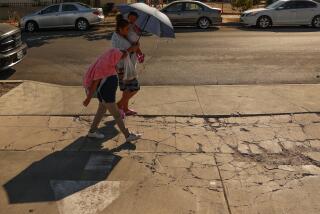Oxnard hospital seeks a second mold abatement
Plagued for years by mold infestation, St. John’s Regional Medical Center in Oxnard may tent and fumigate the entire 230-bed facility to attack spores found throughout the building, including in patient rooms, according to hospital officials and court documents.
Other remedies could include demolishing and replacing showers, walls, windows and the entire stucco exterior of the 14-year-old hospital -- at costs that could run as high as $87 million, according to hospital estimates.
“We will not commit to a new remediation process before we understand it to be effective, safe and providing for as little disruption as possible to our operations,” said Rita O’Connor, hospital spokeswoman.
Fumigation would necessitate shutting down the medical center for at least a month, according to one source familiar with the project who did not want to be identified for fear of reprisal. The hospital, which admitted 11,500 patients last year, has made tentative plans to close in late May, the source said.
O’Connor declined to confirm the timing, saying no decisions have been made.
She said no patients or employees have been sickened by the mold. But a toxicologist hired by St. John’s to assess the fungal contamination testified last fall that the potential for infections or allergic reactions exists.
In a court declaration, Mission Viejo toxicologist Harry Skalsky said he found potentially harmful levels of Stachybotrys spores at the hospital. The presence of the spores “may lead to or exacerbate allergic reactions and/or cause toxic effects or infections,” Skalsky stated in the court document.
Exposure to Stachybotrys spores is not a serious health risk for the general population, according to the Centers for Disease Control and Prevention in Atlanta. But people with immune suppression or underlying lung disease are more susceptible to fungal infections, the center advises on its website, www.cdc.gov.
Mold has plagued the sprawling medical campus at Gonzales Road and Rose Avenue almost from the moment it opened its resort-like doors in late 1992.
In 15 volumes of court documents at the Ventura County Courthouse, hospital officials traced the problem to the medical center’s construction.
In 1996, Catholic Healthcare West, the San Francisco-based nonprofit that owns the hospital, sued the general contractor, Centex Rodgers, alleging that shoddy construction had allowed water to seep into the building’s interior. Whenever it rained, moisture filtered down through ill-fitting windows and joints, the hospital’s engineering experts testified.
Over the years, mold began to accumulate around patient showers, ceiling tiles and inside drywall.
After years of legal wrangling, Centex agreed to repair 1,100 windows and more than 200 patient room showers that were leaking and to remove moldy interiors, court documents show.
But in the hospital’s view, the fix turned into an even greater disaster. The new showers leaked into walls and through the catch basins, St. John’s attorneys alleged in court filings.
Some of the new windows leaked, sealant applied to the hospital’s exterior walls was ineffective, and mold spores that should have been detected were left in place, the hospital’s lawyers said.
In 2003, St. John’s filed a second lawsuit, naming Centex and 14 other firms involved in the remediation work. Late last year, it had reached settlements totaling $28.6 million with Centex and most of the subcontractors.
The hospital alleges that the sole remaining defendant, Mactec Engineering and Consulting, was responsible for swab-and-air testing to make sure all the mold had been removed. Its failure to do so resulted in more mold and the need for a second major removal effort, St. John’s said in court documents.
Fungal patches have been found in virtually all private patient rooms and along hospital corridors, according to court documents filed by Catholic Healthcare West.
Skalsky, the toxicologist, said field tests performed after the first removal effort showed that high levels of Stachybotrys spores still were present inside the hospital. He attributed the reinfestation to rotted drywall that was not removed and to Mactec’s failure to detect remaining spores.
As a result, Skalsky said, “every room must be remediated and cleared again.”
Attorneys for Mactec did not return phone calls.
In an e-mail, hospital spokeswoman O’Connor disputed that patients are at risk, saying, “There have been no confirmed cases of patients or employees having been sickened by a mold infection acquired at the hospital.”
*
catherine.saillant@latimes.com
More to Read
Sign up for Essential California
The most important California stories and recommendations in your inbox every morning.
You may occasionally receive promotional content from the Los Angeles Times.










